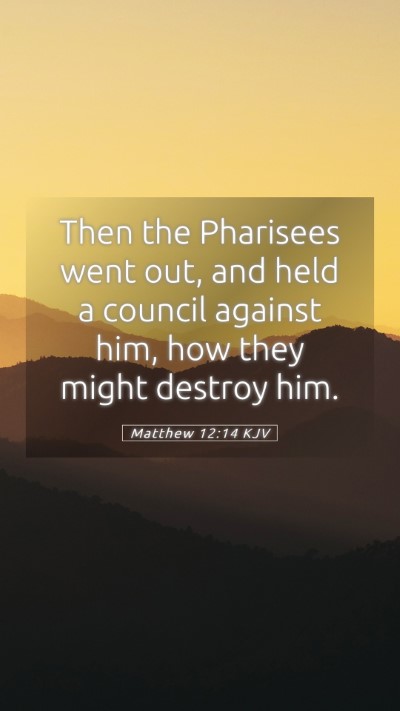Understanding Matthew 12:14
Matthew 12:14 states, "But the Pharisees went out and conspired against Him, how they might destroy Him." This verse captures a significant moment in the ministry of Jesus, illustrating the growing tension between Him and the religious leaders of the day.
Bible Verse Meanings and Interpretations
This passage is pivotal in understanding the conflict of Jesus with the Pharisees, who were intent on preserving their authority and tradition over embracing Christ's transformative message. Here’s a summarized exegesis from various public domain commentaries:
-
Matthew Henry:
Henry explains that the Pharisees' actions reflect their deep-seated animosity towards Jesus. Their conspiracy to destroy Him highlights their unwillingness to accept His teachings and their fear of losing influence. Henry emphasizes that this reaction shows the consequences of spiritual blindness and resistance to divine truth.
-
Albert Barnes:
Barnes notes that this verse illustrates the extent to which the religious leaders would go to eliminate Jesus as a threat. Their concerted effort to conspire against Him showcases their prioritization of tradition and law over compassion and truth. He asserts that such opposition is common whenever truth confronts established norms.
-
Adam Clarke:
Clarke highlights the severity of the plot against Jesus, suggesting that it symbolizes a complete rejection of God’s messenger. He also posits that this moment signifies a turning point where the religious leaders openly determined to alienate and destroy Jesus rather than adhere to His teachings and perform the works of righteousness.
Scripture Analysis
Matthew 12:14 can be analyzed through various lenses:
-
Historical Context:
This verse is set in a time when political and religious tensions were high. The Pharisees, as influencers of Jewish law, felt threatened by Jesus’ radical interpretations and His popularity among the masses.
-
Thematic Implications:
The themes of rejection and conspiracy highlight the broader narrative of Jesus' ministry, leading to the eventual crucifixion. This moment foreshadows the ultimate sacrifices made by Jesus for humanity.
-
Application to Daily Life:
Understanding this verse encourages believers to reflect on the importance of being open to new interpretations of faith and remaining vigilant against the dangers of spiritual elitism and rejection of truth.
Additional Bible Cross References
- Matthew 11:25-26 - Jesus’ acknowledgment of revealing truth to the humble.
- John 15:18-20 - Jesus speaks about the inevitability of opposition from the world.
- Acts 4:25-29 - The early Church faces similar conspiracies against it.
Conclusion
Matthew 12:14 serves as a poignant reminder of the conflict between darkness and light, tradition and truth. It encourages us to engage deeply with Scripture and examine our responses to divine truths and prophetic voices in our lives. Through a careful study of this verse and others like it, we can enrich our understanding of Bible verse meanings, interpretations, and significance.
Further Exploration
If you are interested in the Bible study insights, consider exploring more about:
- Understanding difficult Bible passages: The importance of context in interpretation.
- In-depth Bible verse analysis: Methods of studying the Bible for personal growth.
- Applying Bible verses to daily life: Practical application of Jesus' teachings.


